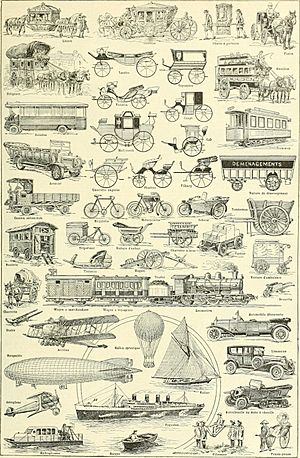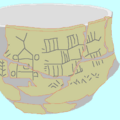Transport facts for kids
Transport is all about moving people or things from one place to another. Think of it as how we get around or send stuff. Transport has three main parts: the infrastructure (the paths we use), the vehicles (what we travel in), and operations (how everything is managed).
Infrastructure means all the paths and places vehicles use. This includes roads, railway tracks, airports, canals, and pipelines. It's like the big network that helps things move. Infrastructure also includes places where journeys start or end, such as airports, train stations, bus stations, and seaports (docks).
Most infrastructure is built by governments. They usually pay for it using taxes collected from people. Experts like civil engineers and urban planners design roads and railways.
Vehicles are the machines that travel on the infrastructure. These include cars, trucks, trains, and airplanes. Engineers who specialize in machines, called mechanical engineers, usually design these vehicles. For water transport, we use vessels like boats, ferries, and barges. These travel on canals and use docks or seaports. Just like trains use train stations, airplanes use airports. And just as trains follow railway lines, airplanes follow special flight paths in the sky.
Operations are the rules and systems that control how transport works. This includes things like traffic signals, railway signals, and air traffic control. Operations also involve government policies (plans for guiding decisions) and regulations (rules or laws). These help manage the system. Examples are tolls (fees to use certain roads), fuel taxes, and traffic laws.
Contents
How Transport Connects with Communication
Transport and communication are closely linked. Sometimes, you can choose one instead of the other. For example, you might telephone a friend instead of visiting them in person. But transport also needs good communication to work well. For instance, air traffic control uses communication to help many airplanes fly safely. So, when transport increases, communication often increases too, and vice versa.
Transport, Energy, and the Environment
Transport uses a lot of energy. Most vehicles run on hydrocarbons, like oil and gas. Burning these fuels can create pollution, which is bad for the environment. To help reduce pollution, there are environmental regulations (laws) and low-pollution fuels. For example, liquified natural gas pollutes less.
Even with cleaner fuels, as more vehicles are used, more pollution is created overall. Fuels like ethanol and biodiesel are also options that pollute less than regular petroleum.
Different Ways to Travel
Transport can happen in three main ways: by land, by water, or by air.
Land Transport
Land transport includes walking, using roads, and traveling on railway tracks. People use bicycles, cars, buses, and vehicles like trains to move across land.
Water Transport
Water transport uses ships and barges. These vessels travel in canals, rivers, and across seas.
Air Transport
Air transportation involves using airplanes and helicopters. These vehicles fly in the sky and use airports for taking off and landing.
Images for kids
-
An Air France A380 on approach to Washington Dulles International Airport
-
An Air France Airbus A318 lands at London Heathrow Airport.
-
Intercity Express, a German high-speed passenger train
-
The Harbor Freeway is often heavily congested at rush hour in Downtown Los Angeles.
-
Automobile ferry in Croatia
-
A Fiat Uno in 2018
-
Incheon International Airport, South Korea
-
Freight train with shipping containers in the United Kingdom
-
Transport is a key component of growth and globalization, such as in Seattle, Washington, United States.
-
The engineering of this roundabout in Bristol, United Kingdom, attempts to make traffic flow free-moving.
-
Traffic congestion persists in São Paulo, Brazil, despite the no-drive days based on license numbers.
-
Bronocice pot with the earliest known image of a wheeled vehicle in the world, found in Poland
-
The Wright brothers' first flight in 1903
See also
 In Spanish: Transporte para niños
In Spanish: Transporte para niños



















